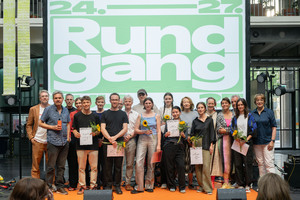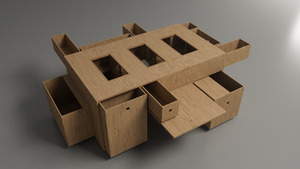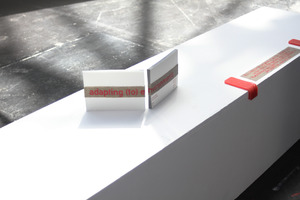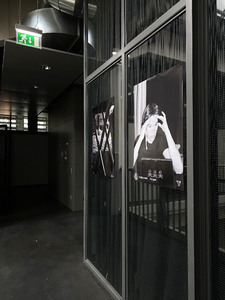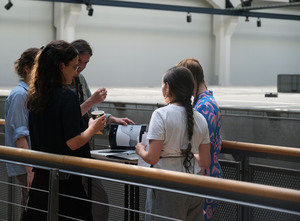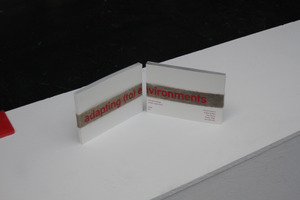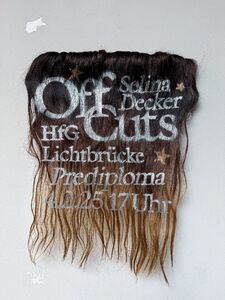Sets
315 Inhalte
- Seite 1 von 27
Shifting Paradigms Symposium
- Titel
- Shifting Paradigms Symposium
- Autor/in
- Schlagworte
- Datierung
- 05.12.2024
- Titel
- Shifting Paradigms Symposium
- Importiert am
- 25.08.2025
- Übergeordnete Sets
- 0
- Set enthält
- 0 0
Preisverleihung Rundgang 2025
- Titel
- Preisverleihung Rundgang 2025
- Autor/in
- Datierung
- 24.07.2025
- Titel
- Preisverleihung Rundgang 2025
- Importiert am
- 28.07.2025
- Übergeordnete Sets
- 0
- Set enthält
- 0 18
Stella Kramrisch. Kunsthistorikerin zwischen Europa und Indien.
- Titel
- Stella Kramrisch. Kunsthistorikerin zwischen Europa und Indien.
- Untertitel
- Ein Beitrag zur Depatriarchalisierung der Kunstgeschichte
- Autor/in
- Beschreibung (de)
- Warum gab es keine bedeutenden Kunsthistorikerinnen? Das Buch „Stella Kramrisch“ sucht in der Kunstgeschichtsschreibung der letzten Jahrzehnte nach einer Antwort auf diese polemische Frage. Die Erklärung für das Fehlen von Kunsthistorikerinnen findet sich in den misogynen und patriarchalen Strukturen der Geschichtsschreibung. Um die Reproduktion ebendieser Strukturen zu unterbrechen, ist das Buch dem Werk und Wirken der Kunsthistorikerin Stella Kramrisch (1896 –1993) gewidmet.
Stella Kramrisch war in den 1920er bis 1940er Jahren eine gefragte Expertin für indische Kunst. Aufgewachsen und promoviert in Wien, lehrte sie ab den frühen 1920er Jahren an Universitäten in Bengalen. Sie argumentierte für die Eigenständigkeit des künstlerischen Wertes indischer Architektur, Skulptur und Malerei. Während ihrer Zeit in Bengalen verbreitete sie ihre Thesen durch wirkungsmächtige Ausstellungen und Publikationen in Europa. Möglich war das durch die Zusammenarbeit mit Institutionen wie dem Wiener Institut für Kunstgeschichte, Springers Handbuch Kunstgeschichte, der Reformbewegung und dem Warburg Institut. Warum wissen wir nichts von dieser Tänzerin zwischen Kulturen, der scharfen Beobachterin und poetisch präzisen Autorin? Das Buch zielt auf die Erschließung des Werkes, der Methoden und des Kunstbegriffs von Kramrisch ab.
- Warum gab es keine bedeutenden Kunsthistorikerinnen? Das Buch „Stella Kramrisch“ sucht in der Kunstgeschichtsschreibung der letzten Jahrzehnte nach einer Antwort auf diese polemische Frage. Die Erklärung für das Fehlen von Kunsthistorikerinnen findet sich in den misogynen und patriarchalen Strukturen der Geschichtsschreibung. Um die Reproduktion ebendieser Strukturen zu unterbrechen, ist das Buch dem Werk und Wirken der Kunsthistorikerin Stella Kramrisch (1896 –1993) gewidmet.
- Beschreibung (en)
- Why were there no great women art historians? The book “Stella Kramrisch” seeks an answer to this polemical question in the art historiography of the last few decades. The explanation for the absence of women art historians is found in the misogynistic and patriarchal structures of much history writing. To interrupt the reproduction of these very structures, the book focuses on the work and activities of the art historian Stella Kramrisch (1896-1993).
In Europe, Stella Kramrisch was a sought-after expert on Indian art from the 1920s to the 1940s. Raised and graduated in Vienna, she taught at universities in Bengal from the early 1920s. Central to her research was the argument for the autonomy of the artistic value of Indian architecture, sculpture, and painting. During her time in Bengal, she spread her theses through influential exhibitions and publications in Europe. This became possible through collaborations with institutions such as the Vienna Institute for Art History, Springer’s Handbook of Art History, the Reform Movement, and the Warburg Institute. Why do we know nothing of this dancer between cultures, a keen observer and poetically precise writer? The book aims to make Kramrisch’s works, methods, and concept of art accessible.
- Why were there no great women art historians? The book “Stella Kramrisch” seeks an answer to this polemical question in the art historiography of the last few decades. The explanation for the absence of women art historians is found in the misogynistic and patriarchal structures of much history writing. To interrupt the reproduction of these very structures, the book focuses on the work and activities of the art historian Stella Kramrisch (1896-1993).
- Kategorie
- Typ des Projekts/Werks
- Schlagworte
- Ort: Institution
- Titel
- Stella Kramrisch. Kunsthistorikerin zwischen Europa und Indien.
- Projektleiter/in
- Semester
- Studiengang
- Typ der Abschlussarbeit
- Importiert am
- 28.07.2025
- Übergeordnete Sets
- 1
- Set enthält
- 0 2
Topologie des Verschwindens
- Titel
- Topologie des Verschwindens
- Autor/in
- Beschreibung (de)
- Am Anfang steht nicht die Form, sondern die Haltung. Genau das ist das bewusste und kritische Bewusstsein für den Raum. Was bedeutet es, wenn Architektur verschwindet? Was bleibt übrig, wenn das Nützliche, Sichtbare und Funktionale entfernt wird? Genau an diesem Punkt beginnt der eigentliche reflexive Handlungsspielraum des Künstlers. Anders gesagt: Es öffnet sich ein Denkraum, in dem nach den Bedingungen des Seins gefragt, die wesentlichen Strukturen der Dinge erprobt und noch nicht geformte Möglichkeiten konfrontiert werden. Denn jeder Akt der Entfernung ist ein Akt, der die Bedingungen für latente Bedeutung und Gestalt offenbart. So erscheint im Verschwinden etwas Neues.
In jeder Phase dieser Arbeit spiegelt sich ein bewusster und reflektierender Eingriff wider – eine Art choreografierter Dialog mit Struktur, Erinnerung und Bedeutung. Das Entfernen von Strukturen, das Imaginieren von Kästen, die Transformation des Innenhofs – all diese Eingriffe sind Akte der Erkenntnis und kritische Selbstbefragungen des Raums: „Was bin ich, wenn ich nicht mehr funktioniere?“ Dass Architektur ihre Funktion verliert, bedeutet, dass sie in einen Zustand des Schweigens gerät, in dem sie sich selbst nicht mehr erklären oder zeigen kann. Diese Fragen führen ganz natürlich zu einer weiteren: Wenn Architektur schweigt – wer bringt dann ihre innere Erinnerung und Struktur zum Sprechen?
Diese Arbeit basiert auf einer Annahme: Ein Tisch, der einst angefertigt, aber nie ausgestellt wurde, hat lange Zeit im Depot des Museums verbracht. Nun wird dieser Tisch in die Mitte des Ausstellungsraums gebracht – ein symbolischer Akt der Öffnung der in der Struktur versiegelten Erinnerung und des Wiedererscheinens einer verstummten Form. Die Form dieses Tisches verweist jedoch auf die Struktur des Gebäudes, in dem er sich befindet. Mit anderen Worten: Der Tisch ist ein Wesen, das die Erinnerung der Architektur, zu der er gehört, verinnerlicht hat. Indem er aus dem Ursprung geschaffen wurde und in diesen Ursprung zurückkehrt, rechtfertigt der Tisch seine Existenz als bedeutungstragende Entität im Raum.
Den Tisch in die Mitte zu stellen – als Vermittler und Übersetzer der Geschichte – ist keine zufällige Entscheidung. Es ist eine Metapher für die Rückkehr zur Oberfläche, zum Ausdruck, zur Geste der Öffnung. Innerhalb der Struktur, die er widerspiegelt, wird der Tisch zur Schnittstelle zwischen Betrachter und Struktur, zwischen Erinnerung und Gegenwart. Er fordert Handlung – doch jede Handlung ist der Beginn einer Interpretation, die eine potenzielle Erzählung liest, und jede Öffnung ist ein erbetener Dialog.
Wenn Architektur nicht mehr funktioniert, schweigt sie wie eine vergessene Sprache, deren Worte verstummt sind. Doch künstlerisches Eingreifen bringt dieses Schweigen wieder zum Sprechen. Diese Arbeit versteht Architektur als Sprache – eine vergessene, verschüttete, zum Schweigen gebrachte Sprache, die durch das Denken des Künstlers wieder sprechen lernt. Was hier gezeigt wird, ist ein materiell verdichteter Denkprozess. Es ist eine Erzählung, die sich durch Entfernung, Rekonstruktion und symbolische Neueinschreibung entfaltet.
In diesem Sinne ist die Arbeit selbst eine Topologie des Denkens über das Verschwinden – eine künstlerische, selbstreflexive Karte, die erforscht, wie Erinnerung und Struktur, Form und Bedeutung miteinander in Beziehung stehen, wie sie verteilt werden und wie sie wieder zu einer Erzählung verbunden werden. Jede Linie, die sie bildet, ist eine Handlung, und jede Handlung ist ein Satz im inneren Dialog der Form.
- Am Anfang steht nicht die Form, sondern die Haltung. Genau das ist das bewusste und kritische Bewusstsein für den Raum. Was bedeutet es, wenn Architektur verschwindet? Was bleibt übrig, wenn das Nützliche, Sichtbare und Funktionale entfernt wird? Genau an diesem Punkt beginnt der eigentliche reflexive Handlungsspielraum des Künstlers. Anders gesagt: Es öffnet sich ein Denkraum, in dem nach den Bedingungen des Seins gefragt, die wesentlichen Strukturen der Dinge erprobt und noch nicht geformte Möglichkeiten konfrontiert werden. Denn jeder Akt der Entfernung ist ein Akt, der die Bedingungen für latente Bedeutung und Gestalt offenbart. So erscheint im Verschwinden etwas Neues.
- Kategorie
- Typ des Projekts/Werks
- Datierung
- 23.07.2025
- Technik/Verfahren/Formate
- digitale Modellstudie
- Titel
- Topologie des Verschwindens
- Projektleiter/in
- Studiengang
- Importiert am
- 23.07.2025
- Übergeordnete Sets
- 0
- Set enthält
- 0 7
Objekte
- Titel
- Objekte
- Autor/in
- Datierung
- 02.07.2025
- Titel
- Objekte
- Studiengang
- Typ der Abschlussarbeit
- Importiert am
- 22.07.2025
- Übergeordnete Sets
- 1
- Set enthält
- 0 4
Ausstellung
- Titel
- Ausstellung
- Autor/in
- Datierung
- 02.07.2025
- Titel
- Ausstellung
- Studiengang
- Typ der Abschlussarbeit
- Importiert am
- 22.07.2025
- Übergeordnete Sets
- 1
- Set enthält
- 0 5
Publikation
- Titel
- Publikation
- Autor/in
- Datierung
- 02.07.2025
- Titel
- Publikation
- Studiengang
- Typ der Abschlussarbeit
- Importiert am
- 22.07.2025
- Übergeordnete Sets
- 1
- Set enthält
- 0 7
rethinking public space
- Titel
- rethinking public space
- Titel (en)
- rethinking public space
- Autor/in
- Beschreibung (de)
- „rethinking public space“ ist ein Projekt, das sich mit Street-Skating und Skate-Kultur befasst und untersucht, wie Skateboarder öffentliche Räume neudenken und umgestalten können.
Das Projekt besteht aus einer Publikation mit Fotos von Street-Skate-Spots und Interviews. Es enthält ein Interview mit der Stadt Stuttgart, über den Bau von Skateparks, DIY-Parks und Skate-Stoppern, und ein zweites Interview mit einem Skateboarder und Content Creator aus San Diego, der über die Skate-Kultur, ihre Beziehung zur Öffentlichkeit und die kreativen Wege spricht, mit denen Skateboarder Herausforderungen überwinden.
Die Publikation funktioniert wie ein Daumenkino, das alle Skate-Spots aus dem gleichen Blickwinkel zeigt und die Bewegung des Grindens durch sie hindurch nachahmt, unterbrochen nur durch Skate-Stopper-Seiten. Darauf folgen die Interviews.
Die Publikation ist in ein mit Wachs versiegeltes, siebgedrucktes Stoffband mit dem Namen der Publikation eingewickelt.
Weitere Wachsbänder, die jeweils einen Auszug aus einem der Interviews zeigen, sind über die gesamte Ausstellung verteilt.
Ein weiteres Element des Projekts auf Wachsbasis sind die Skatestopper-Wachsrepliken, die den Skatestoppern in Karlsruhe nachempfunden sind und das Skateboarden ermöglichen, anstatt es zu verhindern.
Begleitend zur Publikation gibt es eine Rampe aus alten Straßenschildern und Holzabfällen sowie eine Rail aus einem alten Rutschen-Seitenteil. Diese Elemente sind eine Hommage an DIY-Skate-Spots und nutzen kostengünstige, leicht verfügbare Ressourcen.
- „rethinking public space“ ist ein Projekt, das sich mit Street-Skating und Skate-Kultur befasst und untersucht, wie Skateboarder öffentliche Räume neudenken und umgestalten können.
- Beschreibung (en)
- 'rethinking public space' is a project focusing on street skating and skate culture, as well as exploring how skateboarders can reuse and reshape public spaces.
The project consists of a publication containing photographs of street skate spots and interviews. There is one interview with a city official talking about the process of building skate parks, DIY parks and skate stoppers, and a second interview with a skateboarder and content creator from San Diego talking about skate culture, its relationship with the public, and the creative ways skateboarders overcome obstacles.
The publication functions as a flipbook, showing all the skate spots from the same angle and emulating the motion of grinding through them, interrupted only by skate stopper pages. These are followed by the interviews.
The publication is wrapped in a wax-sealed, screen-printed cloth band bearing the publication's name.
More wax bands, each showcasing an excerpt from one of the interviews, are spread throughout the exhibition.
Another wax-based element of the project is the skatestopper wax replicas, modelled on those found in Karlsruhe, which enable skateboarding rather than prevent it.
Accompanying the publication is a ramp made from scrap street signs and discarded wood, as well as a rail made from an old slide side piece. These elements pay homage to DIY skate spots and utilise affordable, readily available resources.
- 'rethinking public space' is a project focusing on street skating and skate culture, as well as exploring how skateboarders can reuse and reshape public spaces.
- Kategorie
- Typ des Projekts/Werks
- Schlagworte
- Datierung
- 02.07.2025
- Dank an
- Sprache
- Material
- Technik/Verfahren/Formate
- Siebdruck, Lumbecken, Folienplott,
- Abmessungen
- Breite: 195mm, Höhe: 140mm
- Ort: Institution
- Ort
- Unter der Lichtbrücke
- Stadt
- Land
- Titel
- rethinking public space
- Projektleiter/in
- Semester
- Studiengang
- Typ der Abschlussarbeit
- Importiert am
- 21.07.2025
- Übergeordnete Sets
- 0
- Set enthält
- 3 0
Approaching X
- Titel
- Approaching X
- Autor/in
- Beschreibung (en)
- What is X anyway? What does X mean to me and what does it mean to others? Where is X used and what do we see in it? What do we project onto X? Do we need to define X?
This projects goal was to find an approach to what the letter, the symbol, the figure X means to different people. Starting out as obsession with seeing the pattern of three Xes everywhere in my daily life , this work led to a collection of the meanings that X might or might not inherit and is an Invite to look for the pattern as well. I present my current approach to the theme of X; trying to find a way of connecting different ideas into a pattern. It runs through my life—and really through all of ours—and I share my perspective with the viewer. In my exhibition, I captured my exploration in 22 posters and a 130-page publication.
- What is X anyway? What does X mean to me and what does it mean to others? Where is X used and what do we see in it? What do we project onto X? Do we need to define X?
- Kategorie
- Typ des Projekts/Werks
- Schlagworte
- Datierung
- 02.07.2025
- Dank an
- Sprache
- Material
- Technik/Verfahren/Formate
- Lumbeck-Verfahren,
- Abmessungen
- 594X420
- Ort: Institution
- Ort
- Der Gang neben der PD-Sauna und dem Glaskubus im 2.OG, ebenfalls die Brücke zum ZKM im 2.OG
- Stadt
- Land
- Bemerkungen
- Dieses Projekt besteht teils aus eigenen, teils aus mir zugesendeten Bildern, deren Rechte mir übertragen wurden
- Titel
- Approaching X
- Importiert am
- 21.07.2025
- Übergeordnete Sets
- 0
- Set enthält
- 2 18
OffCuts
- Titel
- OffCuts
- Autor/in
- Beschreibung (de)
- Ich habe menschliches Haar als Material und Textil erforscht. Haare sind etwas zutiefst Persönliches, aber auch eine weithin verfügbare und oft weggeworfene Ressource. Im Rahmen meiner Recherchen habe ich das Material aus verschiedenen Blickwinkeln - wissenschaftlich, kulturell und künstlerisch - untersucht und gleichzeitig mit ihm gearbeitet, um Textilien und Teppiche mit verschiedenen Techniken herzustellen.
- Beschreibung (en)
- I explored human hair as a material and textile. Hair is something deeply personal, yet it is also a widely available and often discarded resource. Through my research, I examined the material from different perspectives - scientific, cultural, and artistic, while also working hands-on with it to create textiles and carpets using various techniques.
- Kategorie
- Typ des Projekts/Werks
- Schlagworte
- Datierung
- 04.02.2025
- Mitwirkende
- Material
- Ort: Institution
- Titel
- OffCuts
- Projektleiter/in
- Semester
- Studiengang
- Typ der Abschlussarbeit
- Importiert am
- 21.07.2025
- Übergeordnete Sets
- 0
- Set enthält
- 0 7
